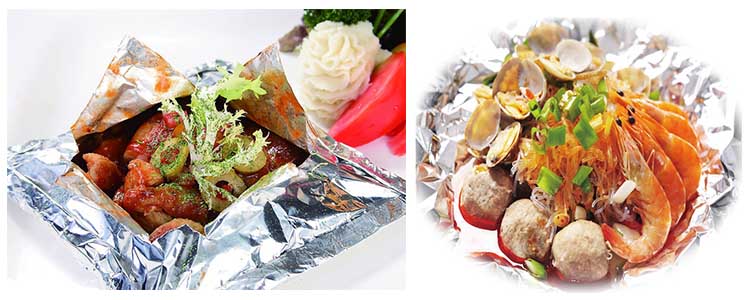
Household aluminum foil's barrier qualities make it a useful storing material.Household aluminum foil's ability to keep food fresh is due to its better barrier properties:
On the atomic scale, the tight molecular lattice structure forms an almost impenetrable barrier to gases such as oxygen and carbon dioxide.
Thin foil gauges of 0.02 to 0.1mm are often ideal: thick enough to prevent permeability but thin enough to embrace irregular food forms for optimum surface contact area.
Laboratory testing revealed that uncovered items gained 5-15% more weight than foil-wrapped equivalents over two weeks due to moisture absorption into porous surfaces.
By forming a hermetic microclimate insulated from outside air, foil deprives spoilage bacteria of oxygen, which fuels oxidative rancidity while also controlling moisture content.
Slowing oxygen ingression, which causes lipid oxidation processes, reducing taste and nutrients throughout shelf life.
Furthermore, foil reduces water vapor transport, reducing drying and softening from dehydration. Baked items covered in foil tasted fresher for up to 30% longer.
Maintaining such a changed environment under the protective barrier is critical to long-term preservation without preservatives. Household aluminum foil's oxygen-blocking properties may be more important than traditional canning or bottling for many fresh or delicate goods.
While its barrier properties prevent rotting from oxygen and moisture, aluminum foil also provides protection against bacteria.
Experiments on stainless steel culture plates injected with typical foodborne pathogens such as E. coli revealed that adherent bacterium populations were 95% lower on surfaces cleaned with foil compared to porous non-foil substrates.
The slick inert foil structure appears to inhibit the adhesion and multiplication of microorganisms that require a friendly surface for colonization.
Furthermore, aluminum foil provides an efficient physical barrier that prevents cross-contamination between raw and cooked items during storage and transportation.
When viruses are unable to develop a foothold, shelf life increases significantly because the safe pathogen threshold is less likely to be achieved before organoleptic alterations occur.
While foil lacks antibacterial characteristics, its flat, impermeable surface creates an unfriendly environment for spoilage germs to survive and propagate.
Aside from food preservation, 8011 household aluminum foil jumbo roll offers a variety of other useful kitchen applications.
Its excellent thermal conductivity enables quick heat transmission during cooking, resulting in thorough and uniform cooking without drying or burning. It also reduces the cooking time.
8011 household aluminum foil jumbo roll's light-blocking opacity protects photosensitive components such as carotenes from light-induced deterioration, preventing color, taste, and nutrient loss. The greatest way to preserve colorful veggies.Furthermore, compared to throwaway items like plastic wrap, aluminum foil keeps food fresh is clearly more cost effective.
The non-porous surface is readily wiped to preserve cleanliness while reused for storage, which is an important aspect for extending refrigerator usefulness.
Creative aluminum foil. Weighted over wraps, pans, and liners are commonly used to limit moisture migration in fruit, meat, and poultry.
In many ways, aluminum foil keeps food fresh acts like a Swiss Army knife, keeping food fresh throughout the preservation chain, from preparation to final consumption.

While aluminum foil's shelf-stable barrier and heat conductivity make it important for a variety of culinary jobs across the world, its usage are heavily influenced by regional food traditions. Different cultures utilize aluminum foil in different ways for cooking and preservation.This comprehensive investigation examines aluminum foil's many integrations into traditional culinary techniques across the world.
North America
North American pantries contain heavy-duty foil for baking classics.
Casseroles such as lasagna, chicken pot pie, and stacked Jell-O molds use foil to make oven cleanup easier.
Brownies, blondies, and bar cookies are typically foil-baked in large batches for potlucks, bake sales, or casual nibbling.
Grilling steaks, poultry, or vegetables directly on pre-oiled foil allows for easy cleanup of the barbecue grate.
Western Europe
European kitchens employ foil for seasonal specialties and convenience:
Roast potatoes and winter root vegetables often roast tightly foil-wrapped with herbs to efficiently infuse flavor without mess.
Entire baked hams, pork or lamb joints are traditionally cooked insulated in foil for succulent texture.
Quick panini, toasties or late-night pan pizzas are rustled up on foil draped over a griddle for easy ejection.
Middle East
Middle Eastern kitchens apply specialized foil techniques:
mansaf, a lamb stew cooked for days in aumbo wrapped airtight in foil, maintains tenderness.
Shwarma and kebab meats are often marinated securely in foil pouches before overnight grill roasting for intense savor.
Flatbread like saj or naan are poised on preheated foil amid the oven or tandoor for cracker-crisp bottoms.
East Asia
East Asian home cooks maximize foil's steam and insulation attributes:
Steamed buns, dumplings and triangles packed in foil pockets emerge light, fluffy and juicy.
Poached or steamed whole fish are expertly deboned tableside after gentle foil-cooking over steamer water.
Stir-fries, noodles and rice dishes are portioned into individual foil bags or ramekins for quick microwave reheating.
South Asia
South Asian cuisine exploits foil's conductive abilities:
Dosa and uttapam griddle-baked crepe pancakes gain crispy golden bottoms on foil lined with oil.
Paratha and poori flatbreads are flash-fried to inflated puffiness on foil before serving still hot.
Biryani and pilaf rice pilafs steam nestled under foil tents on slow-cooking stovetops until fluffy yet distinct.
Africa
Across African nations, foil serves staple preparations:
Injera, cassava and fufu flatbreads steam perfectly pliable atop foil over pots of boiling water.
Meat and fish stewed with peanuts or grains in foil pouches emerge fall-off-the-bone tender.
Maize and plantain tubers are commonly buried in hot ash then foil to gently roast underground-style.
So whether enhancing baking, roasting, steaming or frying globally, aluminum foil ubiquitously facilitates traditional cuisines worldwide with its unique material properties. Its culinary versatility matches only imagination.
HTMM Aluminum Foil factory manufacture high quality food grade aluminum foil for kitchen use more than 10 years.Have customers all over the world,more than 70 countries.If you are searching for a credible supplier,they must be your best choice.





